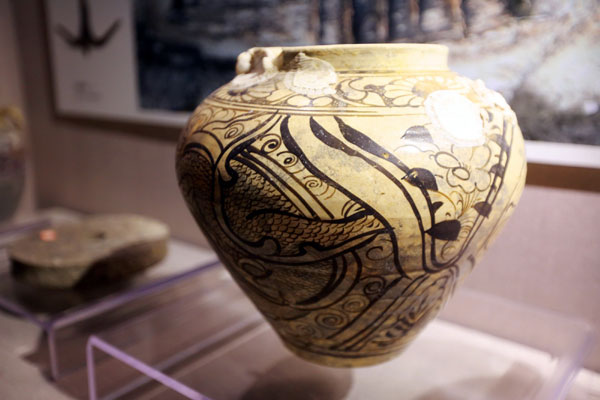 |
|
A porcelain vase of the Yuan Dynasty (1271-1368) from Penglai Museum in Shandong province is on display at the show.[Photo by Dai Hang/China Daily] |
"It is the genuine one this time."
Xie Bizhen, a historian with Fujian Normal University, notes the exhibition spotlights Fujian's important role in the Maritime Silk Road: The province is the only one that has three cities presenting artifacts in the exhibition.
Zhangzhou displays its trademark blue-and-white porcelain as well as Dutch coins, while Fuzhou, the provincial capital, presents the exported clothes and the craftsmanship of building vessels, highlighting Fujian province's heyday as a major hub for marine trade, Xie says.
Chen Xiangshun, a collector from Quanzhou, says the exhibition reflects the country's archaeological research achievements.
The treasure horde of cultural relics on display, including chess pieces and coins, have been discovered from sunken merchant vessels of the Song Dynasty, which were loaded with porcelain ware and have been salvaged from the South China Sea in recent years, Chen says.
"It is hard to find those precious pieces, but they now remind me that there are still lots of other mysteries deep in the vast sea to be discovered," Chen says.
The discoveries related to historical routes that link various cultures are getting international attention, and the Maritime Silk Road is an amazing network connecting the East and West, Xie says.
Last October, during his visit to members of the Association of Southeast Asian Nations, Chinese President Xi Jinping proposed the cooperation initiative of the 21st Century Maritime Silk Road.
"The exhibition offered inspiration to build a modern Maritime Silk Road, reminding us to take advantage of the experience we've had before to establish a mutual beneficial relationship with foreign countries," Xie says.
To add fun for the younger generation of visitors, interactive games that invite children to identify a cultural relic based on a description have been designed, and winners could get postcards of the city that displays the item.
After the Quanzhou leg, the exhibition will go to Nanjing, capital of Jiangsu province, another of the nine cities highlighted in the show, as the tour nears its end.
|
|
|
|
|
|
|
|
